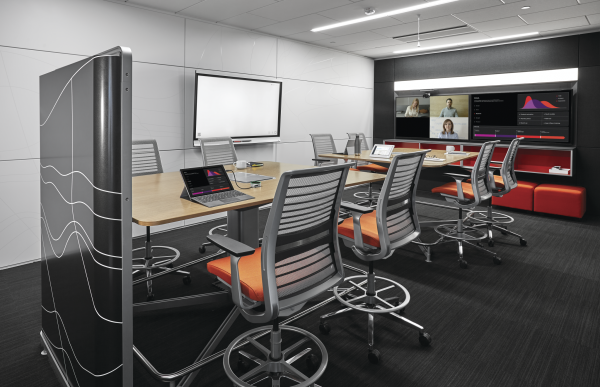When we talk about improving cash flow and creating tighter relationships with customers in the pro AV integrator market, we’re usually talking about the importance of technology integration businesses offering managed service solutions.
That’s important, but it’s not the only way to achieve those two objectives.
I recently visited Red Thread. It had been about a year and a half since I’d visited the Boston-based integration firm specifically to learn about its own office renovation.
Back then, I was impressed with the “walk the walk” approach Red Thread, which is owned by office furniture maker Steelcase, took.
It wasn’t just talking to integration customers about how to leverage AV in a progressive office environment; Red Thread employees in their open-office space were living and breathing with the same collaboration, conferencing, digital signage and soundmasking solutions they work to prepare for clients.
Some of the highlights not typically seen in an integration firm’s office were:
- An open-kitchen café and lounging area with floor-to-ceiling views of Boston Harbor competing with a 3×3 video wall showing social media feeds
- Well-designed huddle and collaboration spaces catering to “nomad” employees without any dedicated workspace moving about based on their tasks
- A 55-inch Microsoft Surface Hub, which Red Thread helped Microsoft launch to the AV market
The office was jaw-dropping impressive. That’s why it was odd to me that when I recently returned John Mitton, VP of Red Thread’s AV group and CTO, wanted to talk about all that had changed.
Truth be told, not all that much had changed — reconfigured huddle space here and new one-person conferencing room there — but the subtle shifts were significant. [related]
“We use ourselves as guinea pigs,” Mitton says. “We go back. We look at what we did. We learn.”
This goes back to the whole “walk the walk” thing. I don’t think technology integration businesses usually do a good enough job of setting an expectation for their customers that they need to continually evaluate their office technology.
For a company that feels like it just drained its budget — a budget that they fought for — the idea that the solution may not end up being a perfect cultural fit or simply that more investment is needed in the not-too-distance future can be a tough pill to swallow.
It’s reality though. Workplaces are in the midst of cultural shifts. Meetings are changing. Employees collaborate differently. Technology and space needs to adapt, but that doesn’t mean every new AV implementation is going to be a home run.
For Red Thread — and for integration customers — it’s important to plan for constant reevaluating. Are the new solutions improving efficiencies? Are they truly being utilized? Are employees happy? What could we have done better?
“If you don’t understand IP networks, do us all a favor and sell your technology integration businesses now,” Jay McArdle, CIO for Zdi, told those in the crowd at a panel discussion during Total Tech Summit.
Red Thread planned for flexibility. “We built on a raised floor, so we’re able to reconfigure very quickly,” Mitton says. “We used demountable walls, so we’re able to readjust walls really quickly.”
The AV integrator also took the critical step of reflecting on its AV implementation, looking at what it did right, what it did wrong and creating a plan to address changes.
“It’s workplace transformation,” Mitton says.
That’s different and more dramatic for customers than simply buying some products. It’s a big enough deal that it ought to be continually evaluated. It’s up to integrators to set that expectation.
In the end, your customers will be happier, their workplace transformation will be more successful — and they’ll value the relationship with their AV integrator more.

















